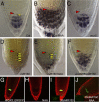Auxin regulates distal stem cell differentiation in Arabidopsis roots
- PMID: 20543136
- PMCID: PMC2900669
- DOI: 10.1073/pnas.1000672107
Auxin regulates distal stem cell differentiation in Arabidopsis roots
Abstract
The stem cell niche in the root meristem is critical for the development of the plant root system. The plant hormone auxin acts as a versatile trigger in many developmental processes, including the regulation of root growth, but its role in the control of the stem cell activity remains largely unclear. Here we show that local auxin levels, determined by biosynthesis and intercellular transport, mediate maintenance or differentiation of distal stem cells in the Arabidopsis thaliana roots. Genetic analysis shows that auxin acts upstream of the major regulators of the stem cell activity, the homeodomain transcription factor WOX5, and the AP-2 transcription factor PLETHORA. Auxin signaling for differentiation of distal stem cells requires the transcriptional repressor IAA17/AXR3 as well as the ARF10 and ARF16 auxin response factors. ARF10 and ARF16 activities repress the WOX5 transcription and restrict it to the quiescent center, where WOX5, in turn, is needed for the activity of PLETHORA. Our investigations reveal that long-distance auxin signals act upstream of the short-range network of transcriptional factors to mediate the differentiation of distal stem cells in roots.
Conflict of interest statement
The authors declare no conflict of interest.
Figures




Similar articles
-
WOX5-IAA17 feedback circuit-mediated cellular auxin response is crucial for the patterning of root stem cell niches in Arabidopsis.Mol Plant. 2014 Feb;7(2):277-89. doi: 10.1093/mp/sst118. Epub 2013 Aug 12. Mol Plant. 2014. PMID: 23939433
-
Auxin gradient is crucial for the maintenance of root distal stem cell identity in Arabidopsis.Plant Signal Behav. 2013;8(12):e26429. doi: 10.4161/psb.26429. Epub 2013 Sep 20. Plant Signal Behav. 2013. PMID: 24056047 Free PMC article.
-
A coherent feed-forward loop in the Arabidopsis root stem cell organizer regulates auxin biosynthesis and columella stem cell maintenance.Nat Plants. 2024 Nov;10(11):1737-1748. doi: 10.1038/s41477-024-01810-z. Epub 2024 Oct 11. Nat Plants. 2024. PMID: 39394505
-
Just passing through: The auxin gradient of the root meristem.Curr Top Dev Biol. 2020;137:433-454. doi: 10.1016/bs.ctdb.2019.12.001. Epub 2020 Jan 7. Curr Top Dev Biol. 2020. PMID: 32143752 Review.
-
Plant primary meristems: shared functions and regulatory mechanisms.Curr Opin Plant Biol. 2010 Feb;13(1):53-8. doi: 10.1016/j.pbi.2009.09.008. Epub 2009 Oct 15. Curr Opin Plant Biol. 2010. PMID: 19836993 Review.
Cited by
-
Functional Mechanisms and the Application of Developmental Regulators for Improving Genetic Transformation in Plants.Plants (Basel). 2024 Oct 10;13(20):2841. doi: 10.3390/plants13202841. Plants (Basel). 2024. PMID: 39458788 Free PMC article. Review.
-
Modulation of cell differentiation and growth underlies the shift from bud protection to light capture in cauline leaves.Plant Physiol. 2024 Oct 1;196(2):1214-1230. doi: 10.1093/plphys/kiae408. Plant Physiol. 2024. PMID: 39106417 Free PMC article.
-
Hormonal Regulation of Stem Cell Proliferation at the Arabidopsis thaliana Root Stem Cell Niche.Front Plant Sci. 2021 Mar 3;12:628491. doi: 10.3389/fpls.2021.628491. eCollection 2021. Front Plant Sci. 2021. PMID: 33747009 Free PMC article. Review.
-
A complex systems approach to Arabidopsis root stem-cell niche developmental mechanisms: from molecules, to networks, to morphogenesis.Plant Mol Biol. 2012 Nov;80(4-5):351-63. doi: 10.1007/s11103-012-9954-6. Epub 2012 Sep 4. Plant Mol Biol. 2012. PMID: 22945341 Review.
-
Application of data fusion modeling for the prediction of auxin response elements in Zea mays for food security purposes.Genomics Inform. 2022 Dec;20(4):e45. doi: 10.5808/gi.22056. Epub 2022 Dec 30. Genomics Inform. 2022. PMID: 36617652 Free PMC article.
References
-
- Dolan L, et al. Cellular organisation of the Arabidopsis thaliana root. Development. 1993;119:71–84. - PubMed
-
- Sarkar AK, et al. Conserved factors regulate signalling in Arabidopsis thaliana shoot and root stem cell organizers. Nature. 2007;446:811–814. - PubMed
-
- Aida M, et al. The PLETHORA genes mediate patterning of the Arabidopsis root stem cell niche. Cell. 2004;119:109–120. - PubMed
-
- Galinha C, et al. PLETHORA proteins as dose-dependent master regulators of Arabidopsis root development. Nature. 2007;449:1053–1057. - PubMed
-
- Vanneste S, Friml J. Auxin: A trigger for change in plant development. Cell. 2009;136:1005–1016. - PubMed
Publication types
MeSH terms
Substances
LinkOut - more resources
Full Text Sources
Other Literature Sources
Medical
Molecular Biology Databases
Research Materials

